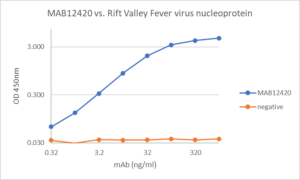
ELISA: Antibody titration against Rift Valley Fever virus nucleoprotein.
Mouse Anti-Rift Valley Fever Virus Nucleoprotein Antibody (IA4)
$406.78 excl. VAT
Purified monoclonal antibody produced by immunisation of mice with recombinant Rift Valley Fever Virus (RVFV) Nucleoprotein (REC31640) manufactured in HEK293 cells. Suitable for use in ELISA.
MOUSE ANTI-RIFT VALLEY FEVER VIRUS NUCLEOPROTEIN (IA4)
Rift Valley Fever nucleoprotein (clone IA4) antibody recognises RVFV N protein and has been manufactured for use in immunoassay development.
PRODUCT DETAILS – MOUSE ANTI-RIFT VALLEY NUCLEOPROTEIN ANTIBODY (IA4)
- Mouse Anti RVFV Nucleoprotein Antibody (Clone IA4).
- Isotype – Mouse IgG1 Kappa.
- Immunogen used RVFV Nucleoprotein, amino acids 2-245 (REC31640).
- Protein G purified, presented in PBS, pH 7.4.
- Suitable for use in ELISA.
BACKGROUND
The RVFV Nucleoprotein forms a filamentous coat that protects RVFV’s RNA genome and is required for RNA replication and transcription by the viral polymerase. Ferron et al. produced a crystal structure, which shows that the nucleoprotein forms a hexameric ring with a high degree of structural flexibility to allow various RNA-binding conformations. Within the inner ring, positive residues are shown to bind RNA and are conserved across Phlebovirus species. Xu et al. surmise that RVFV N-subunit vaccines are able to induce a cell-mediated response to protect against RVFV in mice and demonstrate that the nucleoprotein is a key immunogen during infection.
Rift Valley Fever was first characterized in 1931 in the Rift Valley region of Kenya when it caused an outbreak among livestock. The causative agent – Rift Valley Fever Virus, is an enveloped RNA virus that belongs to the genus Phlebovirus, of the Bunyaviridae family. Bunyaviruses have tripartite genomes, consisting of large, medium and small RNA segments. The small, (S) segment is responsible for encoding Bunyavirus nucleoprotein, which in RVFV is responsible for the formation of ribonucleoprotein complexes, which are essential for the virus life cycle and genome replication (Mottram et al., 2017).
RVFV is an arbovirus, transmitted to domesticated livestock by Aedes and Culex mosquitoes according to their geographical distribution. Cattle, sheep, goats and camels are particularly susceptible to RVF and serve as amplifying hosts for the virus (WHO). RVFV is currently found in sub-Saharan Africa, as well as in Egypt, Yemen, Saudi-Arabia, Mayotte and Madagascar. The continuing geographical expansion of RVFV is also cause for concern in Europe, where the virus is considered to be an emerging threat as reports of RVFV outbreaks in the region have raised concerns that RVFV may spread to temperate climates through emerging, competent vectors. In September 2000, an RVF outbreak was reported in Saudi Arabia and subsequently, Yemen. This outbreak represents the first instance of Rift Valley fever identified outside of Africa.
Infection by RVFV can result in several syndromes, that range from a febrile illness to blindness, encephalitis and lethal hemorrhagic fever. Current vaccines against RVFV are only partially attenuated, cost-prohibitive and only induce short-lived immunity. No specific drugs are available to cure RVFV infection and preventive efforts to avoid new outbreaks are mostly based on monitoring vector distribution.
REFERENCES
- Ferron et al. (2011). The Hexamer Structure of the Rift Valley Fever Virus Nucleoprotein Suggests a Mechanism for its Assembly into Ribonucleoprotein Complexes. Pathogens.
- Mottram et al. (2017). Mutational analysis of Rift Valley fever phlebovirus nucleocapsid protein indicates novel conserved, functional amino acids. Neglected Tropical Diseases.
- World health organisation (WHO). Rift Valley fever.
- Xu et al. (2013) The Nucleocapsid Protein of Rift Valley Fever Virus Is a Potent Human CD8 T Cell Antigen and Elicits Memory Responses. PLoS ONE 8(3).
